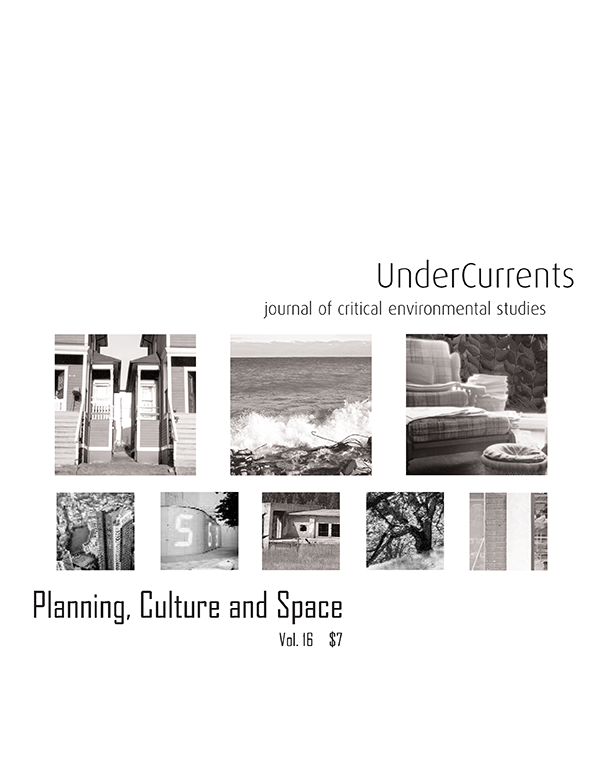Toronto’s Culturally Driven Gentrification
The Creative Class of West Queen West
DOI:
https://doi.org/10.25071/2292-4736/40363Abstract
During the late 1960’s and early 1970’s the North American economy began to see evidence that after decades of prosperity (during the post-war boom) the industrial economy was heading for a collapse (Harvey, 1989; Hannigan, 2004). When the war torn European nations were largely rebuilt and the massive move to the suburbs slowed down, the U.S. economy experienced what Harvey called the ‘crisis of accumulation.’ The economy was overproducing in the face of decreasing foreign and domestic demand, encountering stiffening international competition and coping with rising wages. These factors left profit margins squeezed and started the escalating process of deindustrialization. In an effort to cut costs many manufactures ‘outsourced’ and subcontracted production to smaller firms and to international locations such as Mexico, where there were relaxed labor regulations and abundant workforces prepared to work for low wages.
References
Caulfield, J. (1989). Gentrification and desire. Canadian Review of Sociology and Anthropology 26(4). DOI: https://doi.org/10.1111/j.1755-618X.1989.tb00437.x
City of Toronto. (2003). Culture Plan: for the Creative City. Toronto, Economic Development, Culture & Tourism, Culture Division: 42.
Donald, B. (2002). “Spinning Toronto’s golden age: the making of a ‘city that worked’.” Environment and Planning A 34, 2127-2154. DOI: https://doi.org/10.1068/a34111
Eisinger, P. (2000). “The Politics of Bread and Circuses: Building the City for the Visitor Class.” Urban Affairs Review 35(3). DOI: https://doi.org/10.1177/107808740003500302
Evans, P. (2005). Bohemian dreamin; Developers and creative businesses are revitalizing a tired neighborhood But it’s hurting some who made it hip in the first place. Toronto Star. Toronto: B.01.
Florida, R. (2002). The Rise of the Creative Class: and how it’s transforming work, leisure, community and everyday life. New York, Basic Books.
Hannigan, J. (2004). The new urban political economy. Urban Canada: sociological perspective. H. Hiller. Toronto, Oxford University Press: 246-267.
Harvey, D. (1989). The Urban Experience. Baltimore, The Johns Hopkins University Press. DOI: https://doi.org/10.56021/9780801838491
Kipfer, S. and R. Keil (2002). “Toronto Inc? Planning the Competitive City in the New Toronto.” Antipode 34: 578–601. DOI: https://doi.org/10.1111/1467-8330.00255
Lees, L. (2000). A reappraisal of gentrification: towards a ‘geography of gentrification’. Progress in Human Geography 24(3). DOI: https://doi.org/10.1191/030913200701540483
Peck, J. (2005). Banal Urbanism: creativity as scalar narrative. Studies in Political Economy conference, York University Toronto.
Peck, J. and A. Tickell (2002). Neoliberalizing Space. Antipode 34: 380-404. DOI: https://doi.org/10.1111/1467-8330.00247
Scott, A. J. (2000). The Cultural Economy of Cities. London, Sage.
Short, J. R. (1999). Urban Imagineers: Boosterism and the Representation of Cities. The City as a Growth Machine: Critical Reflections Two Decades Later. D. W. Andrew E. G. Jonas. Albany, State University of New York Press: 37-54.
Slater, T. (2004). Municipally managed gentrification in South Parkdale, Toronto. The Canadian Geographer 48(3). DOI: https://doi.org/10.1111/j.0008-3658.2004.00062.x
Smith, N. (1996). The New Urban Frontier: Gentrification and the Revanchist City, New York: Routledge.
Zukin, S. (1989). Loft Living. New Jersey, Rutgers University Press.
Zukin, S. (1995). The Cultures of Cities, Blackwell Publishers.
Published
How to Cite
Issue
Section
License
Copyright (c) 2007 Brian HracsCreators retain copyright for all writings and artwork published in UnderCurrents. New material published as of Volume 21 (2022) is available under a Creative Commons Attribution 4.0 International License (CC-BY 4.0).


